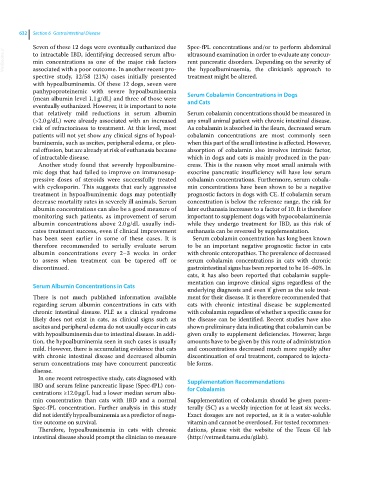Page 664 - Clinical Small Animal Internal Medicine
P. 664
632 Section 6 Gastrointestinal Disease
Seven of these 12 dogs were eventually euthanized due Spec‐fPL concentrations and/or to perform abdominal
VetBooks.ir to intractable IBD, identifying decreased serum albu- ultrasound examination in order to evaluate any concur-
rent pancreatic disorders. Depending on the severity of
min concentrations as one of the major risk factors
associated with a poor outcome. In another recent pro-
treatment might be altered.
spective study, 12/58 (21%) cases initially presented the hypoalbuminaemia, the clinician’s approach to
with hypoalbuminemia. Of these 12 dogs, seven were
panhypoproteinemic with severe hypoalbuminemia Serum Cobalamin Concentrations in Dogs
(mean albumin level 1.1 g/dL) and three of those were and Cats
eventually euthanized. However, it is important to note
that relatively mild reductions in serum albumin Serum cobalamin concentrations should be measured in
(>2.0 g/dL) were already associated with an increased any small animal patient with chronic intestinal disease.
risk of refractoriness to treatment. At this level, most As cobalamin is absorbed in the ileum, decreased serum
patients will not yet show any clinical signs of hypoal- cobalamin concentrations are most commonly seen
buminemia, such as ascites, peripheral edema, or pleu- when this part of the small intestine is affected. However,
ral effusion, but are already at risk of euthanasia because absorption of cobalamin also involves intrinsic factor,
of intractable disease. which in dogs and cats is mainly produced in the pan-
Another study found that severely hypoalbumine- creas. This is the reason why most small animals with
mic dogs that had failed to improve on immunosup- exocrine pancreatic insufficiency will have low serum
pressive doses of steroids were successfully treated cobalamin concentrations. Furthermore, serum cobala-
with cyclosporin. This suggests that early aggressive min concentrations have been shown to be a negative
treatment in hypoalbuminemic dogs may potentially prognostic factors in dogs with CE. If cobalamin serum
decrease mortality rates in severely ill animals. Serum concentration is below the reference range, the risk for
albumin concentrations can also be a good measure of later euthanasia increases to a factor of 10. It is therefore
monitoring such patients, as improvement of serum important to supplement dogs with hypocobalaminemia
albumin concentrations above 2.0 g/dL usually indi- while they undergo treatment for IBD, as this risk of
cates treatment success, even if clinical improvement euthanasia can be reversed by supplementation.
has been seen earlier in some of these cases. It is Serum cobalamin concentration has long been known
therefore recommended to serially evaluate serum to be an important negative prognostic factor in cats
albumin concentrations every 2–3 weeks in order with chronic enteropathies. The prevalence of decreased
to assess when treatment can be tapered off or serum cobalamin concentrations in cats with chronic
discontinued. gastrointestinal signs has been reported to be 16–60%. In
cats, it has also been reported that cobalamin supple-
mentation can improve clinical signs regardless of the
Serum Albumin Concentrations in Cats
underlying diagnosis and even if given as the sole treat-
There is not much published information available ment for their disease. It is therefore recommended that
regarding serum albumin concentrations in cats with cats with chronic intestinal disease be supplemented
chronic intestinal disease. PLE as a clinical syndrome with cobalamin regardless of whether a specific cause for
likely does not exist in cats, as clinical signs such as the disease can be identified. Recent studies have also
ascites and peripheral edema do not usually occur in cats shown preliminary data indicating that cobalamin can be
with hypoalbuminemia due to intestinal disease. In addi- given orally to supplement deficiencies. However, large
tion, the hypoalbuminemia seen in such cases is usually amounts have to be given by this route of administration
mild. However, there is accumulating evidence that cats and concentrations decreased much more rapidly after
with chronic intestinal disease and decreased albumin discontinuation of oral treatment, compared to injecta-
serum concentrations may have concurrent pancreatic ble forms.
disease.
In one recent retrospective study, cats diagnosed with
IBD and serum feline pancreatic lipase (Spec‐fPL) con- Supplementation Recommendations
for Cobalamin
centrations ≥12.0 μg/L had a lower median serum albu-
min concentration than cats with IBD and a normal Supplementation of cobalamin should be given paren-
Spec‐fPL concentration. Further analysis in this study terally (SC) as a weekly injection for at least six weeks.
did not identify hypoalbuminemia as a predictor of nega- Exact dosages are not reported, as it is a water‐soluble
tive outcome on survival. vitamin and cannot be overdosed. For tested recommen-
Therefore, hypoalbuminemia in cats with chronic dations, please visit the website of the Texas GI lab
intestinal disease should prompt the clinician to measure (http://vetmed.tamu.edu/gilab).

